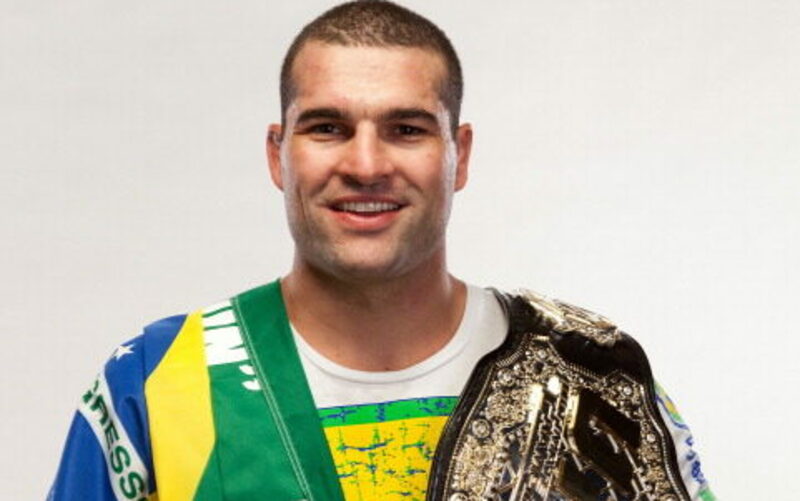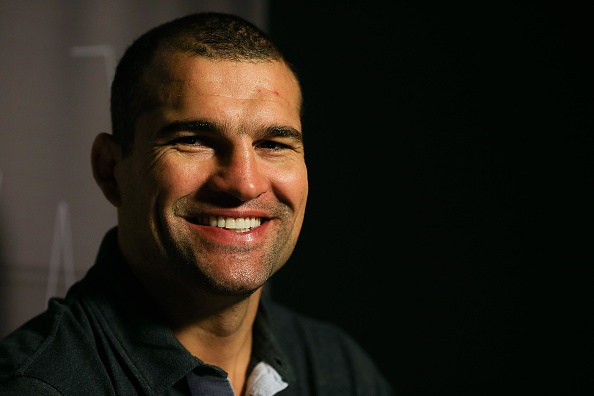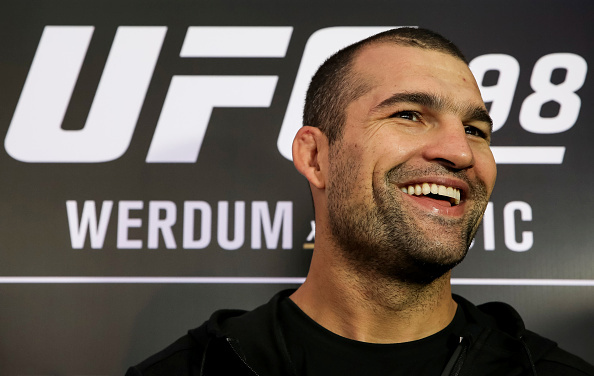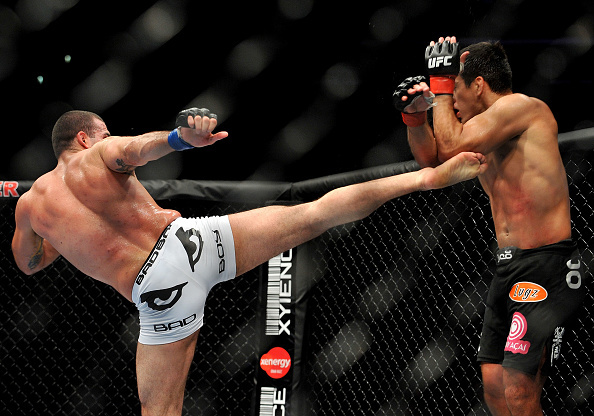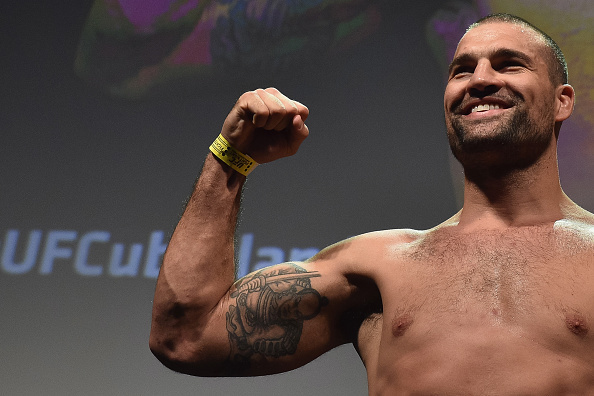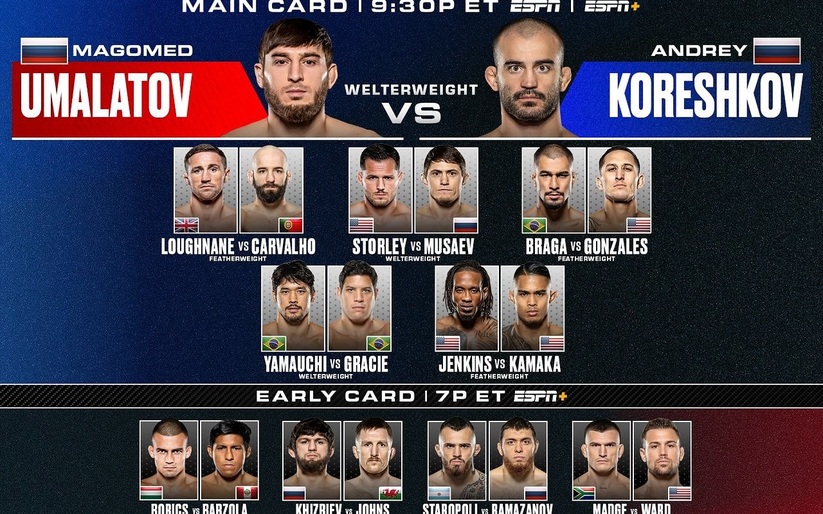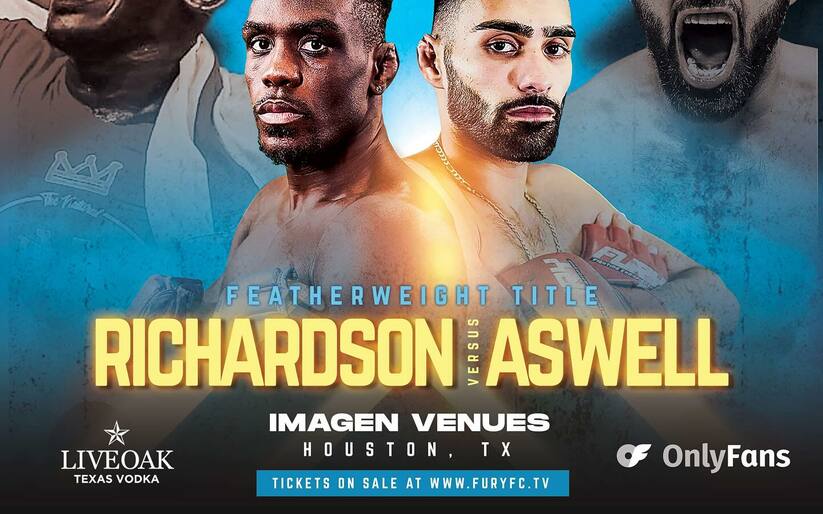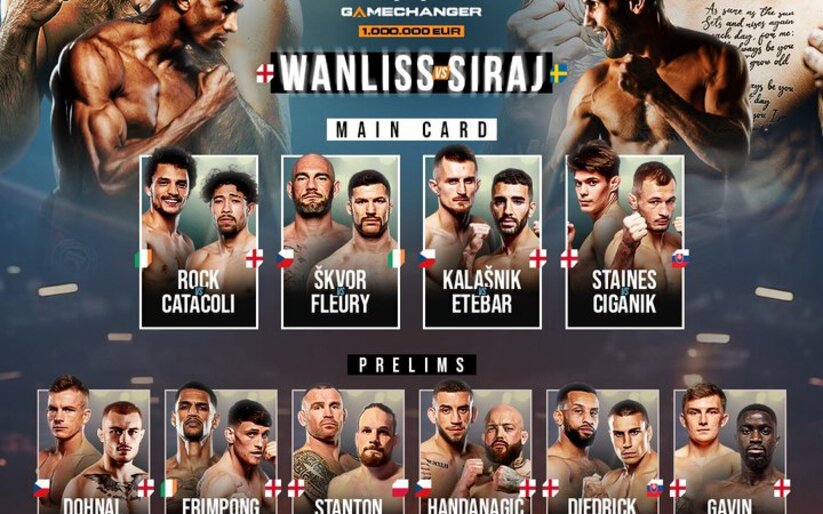An electric tension had filled the air of the Saitama Super Arena. Millions around the world and forty-five thousand fans in attendance watched with bated breath. On the edge of their seats, the fans were about to witness a once-in-a-generation opportunity; an overnight star, the birth of a supernova. Mauricio “Shogun” Rua, a smiling, unassuming, 23-year-old, was about to be launched into superstardom.
Today, Mauricio “Shogun” Rua is well respected by fans and fellow fighters. He is a UFC hall of fame fighter, one of the few athletes to hold titles in both the UFC and PRIDE FC. This Brazilian champion also had some of the most legendary fights in combat sports history. With flying kicks, knees, stomps, and a flurry of punches, Shogun Rua is one of the most exciting and important fighters in history. Through wars, he is one of the crown jewels of the UFC, PRIDE FC, and MMA.
“Love the guy,” UFC and PRIDE Champion, Mark Coleman commented, “Legend, Champ.”
“Shogun is a legend,” said UFC fighter Sam Alvey.
“It was an honor fighting him,” PRIDE fighter and opponent of Shogun, Cyrille Diabaté says.
“Nothing but respect for Shogun,” Ralek Gracie added.
“Shogun is an excellent fighter that brought a very well-rounded skill set to his fights,” said former UFC contender Nate Marquardt. “His fights were always exciting.”
“Elite, not only as a fighter but elite in spirit and heart,” said UFC fighter Danny Chavez, “He had the heart of the champion.”
“He fought with no fear, self-preservation was not in his mind when he was doing battle,” said UFC Champion and Hall of Famer Pat Miletich. “Someone was going out on their shield.”
The Smiling Shogun
Little Brother
“When Shogun came,” Enson Inoue said, “The entire reputation of Shogun was ‘Murilo “Ninja’s” model brother is coming to fight.’ We kind of didn’t expect him to really do that well.”
Shogun Rua was merely 21 years old when he made his debut in PRIDE FC. He had only been training MMA since he was 17 and trained at the legendary Chute-Boxe academy, under the PRIDE Champion Wanderlei Silva. But the real MMA star of the family was his brother Murilo “Ninja” Rua. In the eyes of MMA fans and fighters, he was just the brother of a good MMA fighter, some former model. “Ninja, his brother, was actually the real fighter, and the one who was very famous.” Said Inoue, reflecting on Shogun Rua.
“My biggest reason to get into MMA was my brother, Murilo ‘Ninja’ Rua.” Shogun would tell Heavy in 2009.
Shogun was ordained to stay in the long shadows cast from Wanderlei and Ninja Rua. The very first words about Shogun Rua on a television broadcast were, “There’s the younger brother of Ninja; Mauricio “Shogun” Rua,” from commentator Mauro Ranallo.
Fighters of this era looked like they were Grecian Gods carved of marble. Muscle-bound behemoths such as Mark Coleman, Vitor Belfort, and Wanderlei Silva, was the typical look of fighters of this time. They would flex and give mean looks to their opponent and fans. Shogun Rua showed up to his debut looking like a normal person, and what fans immediately noticed is that he had a bright smile rather than a tough mug.
“Shogun didn’t look like a Mr. Olympia competitor … He had the body of a podcaster who hits the gym a few times a week,” Jon Bois and Felix Biederman said of Shogun, in Fighting in the Age of Loneliness, “[He] smiled bashfully when interviewed.”
Shogun in Tokyo
His PRIDE debut was merely his sixth MMA fight and he would face the much more experienced Akira Shoji. Ninja and Wanderlei were in his corner during this fight. “The fight was a pretty bad beating for Akira Shoji,” MMA Journalist Todd Atkins said. “Shoji was too tough for his own good,” Inoue added. With a flurry of punches, Shogun had passed his first test easily; knocking out the veteran Shoji in under four minutes.
“Pride was special in my career,” Shogun said, “I only want to go in there and do my best. I feel always obligated to put my best effort to give the fans what they want to see, an exciting fight.”
The young Shogun generously shared his bright smile with the audience after brutally knocking out a hometown hero. But Shogun did not showboat after the fight, he simply smiled and posed with Wanderlei and Ninja.
“He was a quiet killer.” PRIDE fighter James “The Colossus” Thompson said, “He was polite and easy to talk to.” And the fans appreciated his calm and friendly demeanor. He would go on to fight three more fighters from Japan and defeat each one by way of KO or TKO, often utilizing stomps and soccer kicks. Despite ruthlessly beating four Japanese stars consecutively the PRIDE fans in Japan respected and liked Shogun; his genuine and friendly attitude helped make him a star.
“And he gained a lot of respect from all of us fighters,” said Inoue. The young Shogun was beginning to carve a name and reputation for himself. He was still best known as the student of Wanderlei and the brother of Ninja. But a tempest was coming. Shogun would soon compete in the 2005 PRIDE Grand Prix. This tournament would permanently alter the MMA landscape and the career of Shogun Rua.
A Supernova
PRIDE FC 2005 Grand Prix
At times, PRIDE FC could feel bigger than sports. It wasn’t just an MMA fight or a tournament; it was a spellbinding atmosphere that could frame a once-in-a-lifetime night. The spectacle that PRIDE created allowed magic to happen in combat sports. And at PRIDE Final Conflict 2005 this was to be one of those nights.
“I was always the underdog … I was the underdog on the whole PRIDE Grand Prix” Shogun adds, “I have only the obligation to do my best.”
Shogun was just a young 23-year-old with a ton of potential. He was about to compete in the most stacked tournament in the history of MMA. Sixteen notable and ranked athletes from all over the world would be competing. The biggest name in MMA Kazushi Sakuraba, the Gracie Hunter, and Wanderlei Silva, the reigning champion, were in the lists. Multiple-time Jiu-Jitsu world champions Dean Lister and Ricardo Arona would open against each other. The 2005 Grand Prix also featured Judo masters Kazuhiro Nakamura, Yoon Dong-Sik, and Olympic Gold Medalist Hidehiko Yoshida. Future K-1 Champion, and UFC contender, Alistair Overeem would meet two-division UFC champion, Vitor Belfort, in the opening round. The Ukrainian wrecking ball Igor Vovchanchyn would face PANCRASE champion, Yuki Kondo. Perennial PRIDE and UFC contender Antônio Rogério Nogueira would face future PRIDE and Strikeforce Champion Dan Henderson. And in the opening round, Shogun would meet the future UFC Champion Quinton “Rampage” Jackson.
Quinton “Rampage” Jackson
Given the stakes of this tournament, the opening round was fought with great caution from most of the fighters, with half the fights going to decision. Rampage Jackson was a favorite to win this match, he was more experienced, had faced better competition, and was a knockout machine. With over half his fights being won by TKO/KO any typical competitor would fight cautiously and carefully. To add to the poetic storyline, Rampage was fresh off of a win against Shogun’s brother, Ninja Rua, in his previous fight. Shogun Rua showed no restraint in this bout.
“In under five minutes, he rocked Jackson, pulverized his body, and bullied him into a corner, where he stomped him,” said Bois and Biederman.
Shogun had dominated Rampage Jackson, broken his rib, and he made it look easy. He used a Thai clinch in addition to swinging punches and stomps. “The stand and bang style, Chute-Boxe mentality,” says MMA Sucka Editor Frazer Krohn. It was a signature performance of a Chute-Boxe alumni Shogun had come to represent. “That fight itself, Rampage set the stage that would propel Shogun beyond his brother,” Adds Atkins.
Antônio Rogério Nogueira and Brazilian Top Team
The young Shogun had moved on from his brother’s shadow and was the second top fighter from the Chute-Boxe Academy, only behind reigning champion and trainer Wanderlei Silva. At the time, two major gyms battled for Brazilian supremacy: Brazilian Top Team and Chute-Boxe.
In the next round of this Grand Prix Shogun would have the opportunity to battle for Brazil and defend Chute-Boxe against Brazilian Top Team‘s Antônio Rogério Nogueira. Nogueira was a higher-ranked fighter, faster, had more experience, more technical punches, and won a national championship in Jiu-Jitsu. “This is when Shoguns luck was supposed to run out,” Bois and Biederman said, “but there was no luck at play.”
The two Brazilian fighters went to war against each other in what is one of the greatest fights in MMA history. They gave each other everything one can in mixed martial arts; trading strikes, power punches, knockdowns, and high-level grappling exchanges. Shogun had only been training for six years and was grappling against a life-long Jiu-Jitsu expert. “His ability to flow between striking and grappling and maintain a tempo was always fun to watch,” Ralek Gracie said, reflecting on Shogun, “His adaptability is what really set him apart.”
With stakes this high neither man backed down and the fight went the full time. A closely fought fight and the judges gave the decision to Shogun Rua. Weeks later would be the final in which the winners would have to fight multiple opponents in one night.
Final Conflict
Alistair Overeem
At Final Conflict 2005, a sold-out Saitama Super Arena was packed with over forty-five thousand fans. This event got a primetime spot on Japanese television, millions were watching in Japan and internationally. Sometimes the raw physicality and great willpower of sport can make moments feel larger than life. Fighters have the opportunity to carve their name in history using the blood of their opponents. MMA is raw and brutal, which can make its greatest moment spectacular.
Shogun was to next meet the towering Dutch fighter Alistair Overeem. Overeem was taller and stronger, he had just won the European ADCC Grappling Championships and was just a few years shy of winning a Kickboxing world title. On his way to meeting Shogun, he submitted his previous two opponents both via guillotine choke. As soon as the bout kicked off, Overeem rushed out of the gate. He secured multiple takedowns, landed knees, and even locked in a guillotine choke. Shogun was able to weather the onslaught and his will could not be broken. He reversed the positions, escaped the guillotine, and landed kicks and knees of his own. Shogun won this fight in the first round landing a flurry of punches from full mount. He advanced to the tournament’s finals; this match would be later in the same night.
Ricardo Arona
Consecutive superstars were falling to Shogun’s wraith of violence. In the next Grand Prix final match, he would meet world Jiu-Jitsu champion Ricardo Arona. Arona was representing the Brazilian Top Team gym and had a body like the prototype of Dwanye ‘The Rock’ Johnson. En route to the finals Arona brutalized and bloodied hometown hero Sakuraba. Arona would next defeat reigning champion, and Chute-Boxe coach, Wanderlei Silva. Defeating Silva was a massive upset at this time as he had not lost in this weight class in 18 fights and five years. Arona and Shogun were destined to meet in the finals. Shogun meeting Arona in the finals meant Shogun would be looking to avenge his coach and defend in his gym in Brazilian gym wars, “The Chute-Boxe Youngster,” commentator Ranallo called him. “One guy is going to win, one guy is going to lose,” said Shogun.
He opened the fight with a spinning tornado kick and was quickly taken to the mat in this fight. On his back, against a Jiu-Jitsu superstar would quickly mean the end. Instead, Shogun attempted a shoulder submission which allowed him to rotate out from under Arona. With Arona now on his back and Shogun standing, Shogun opened the guard and missed a stomp, but quickly landed a multi-punch combination which knocked out Arona. Shogun won the 2005 Grand Prix in under three minutes into the first round. The audience and fans were shocked.
Supernova Champion
“This Mauricio Shogun, 23 years of age, undefeated [in PRIDE] at 7-0, You talk about a Supernova!” said commentator Ranallo. “Unbelievable! What a future, this guy has! Top of the world, at 23! … Unreal!” added commentator, and former UFC champion, Bas Rutten. A smiling Shogun, surrounded by confetti and lights, was receiving his tournament trophy and championship belt. Ranallo says, “The smile tells the story!”
“Shogun Rua epitomizes the legendary era of Pride,” Said MMA journalist Krohn. The underdog who had little chance of winning; a 23-year-old with limited experience who was given the hardest opponents to the final. With the tournament won he defended his gym, avenged his coach, and most importantly changed the landscape of MMA. With mixing high-level jiu-jitsu and Muay Thai, with signature Chute-Boxe tenacity, Shogun was the next evolutionary step in MMA fighters. “The game evolves, and people evolve,” said UFC fighter Chavez. Shogun Rua became an overnight superstar, a supernova. He took the MMA world by storm.
“Those were great days,” He told Heavy in 2009, “I have many great memories … The highlight was the 2005 Grand Prix run when I got the belt. From the first fight with Rampage, going through the fight with Little Nog, and then the finals with Overeem and Arona. It was the best moment I had in PRIDE for sure.”
Stateside
Due to Yakuza ties and controversial stories in the media, PRIDE FC and the combat sports boom era of Japan began to fade. PRIDE would lose its broadcast deals and sponsorships. In a desperate attempt before insolvency PRIDE began doing events away from home and in the USA. When combat sports were having a golden age in Japan, MMA was dead in America. And around this era that began to reverse. Due to the reality show ‘The Ultimate Fighter’ MMA in America was going mainstream and PRIDE would try to jump on the momentum.
Having conquered Brazil and Tokyo, Shogun would now put his sights on the glitz of Vegas and Hollywood. PRIDE was doing shows in the USA featuring the jewel of their organization; Shogun Rua. During this time he would spend time with veteran sports, entertainment, and human-interest writer Loretta Hunt. Hunt recalls a story of Shogun in downtown Los Angeles.
I got to spend a few hours with the Rua brothers when they visited PRIDE’s LA offices in 2006, when the Japanese promotion was gearing up for its first event on U.S. soil. I decided to take the brothers, who spoke very little English at the time, out to California Pizza Kitchen and the Hollywood Walk of Fame.
Along the sidewalk path of stars, there will always be costumed characters that you can take a picture with — for a fee. As the three of us snaked through the crowd, a blonde woman with a thick accent in a Supergirl suit, locked arms with Shogun and pulled him in to take a picture, which he did graciously. I snapped a quick shot on my digital camera.
Of course, she had no idea he was a world-class athlete who’d fought in front of 60-80K audiences and a runway model who couldn’t walk down the street of Brazil without getting mobbed. And he, having been grabbed by her initially, thought she was just a fan.
When she extended her hand and asked for money, Shogun smiled back at her. He really had no idea what she was all about and her broken English did little to clue him in. When she became irate, his smile faded a bit and I pulled him out of there.
Shogun in the UFC
Vengeance
The UFC purchased PRIDE FC and moved their stars over. Mauricio “Shogun” Rua in the UFC became a story of revenge. He would have an earlier loss to Mark Coleman, which he later avenged via TKO. A submission loss to Forrest Griffin, which he later avenged via KO. A decision loss to then-champion Lyoto Machida, which he avenged via first-round knockout.
Shogun couldn’t just take the UFC title in a close fight. His supernova-like career meant that he had to take the UFC championship in a spectacular first-round knockout. Even in the UFC, he became a mega-star and a crown jewel of the organization. Highlight reel knockouts over Machida and Chuck Liddell made him one of the most important figures in the UFC. And, even in losing, it couldn’t just be in simple fashion.
Torch Passing & Jon Jones
He was merely 23-years-old when he conquered the MMA world. He dominated multiple top-ranked opponents in a single calendar year. Upon losing his UFC title it came to represent one of the great torch-passing moments in the history of MMA.
Jon Jones was a standout athlete and UFC talent. He was blazing through quality competition and stayed undefeated. In 2011, Jones was merely 23-years-old and would challenge for the UFC champion against Shogun. Jones would batter him from the opening bell and take his title. It was a dominant and brutal victory. In an incredible 2011 run, Jones would defeat Bellator champion Ryan Bader, UFC and PRIDE Champion Shogun Rua, UFC champions Quinton “Rampage” Jackson and Machida.
In losing his UFC title, Shogun had passed the torch from one all-time great to the next. A whirlwind 2011 to supersede one’s supernova 2005 run. After defeating Shogun, Jones would go on to become one of the greatest fighters in MMA history.
Our heroes and all-time greats are left on their backs staring up at the lights in MMA. Champions don’t get a cozy retirement. A younger fighter gets their hand raised and tells their story from the blood of the previous generation. MMA is a cruel sport that has the highest highs and lowest lows. Our stars show superhuman determination and willpower one fight just to be beaten bloody in their next bout. But Shogun’s legendary career wouldn’t end on his back.
Hall of Fame Covered in Blood
Dan Henderson
A former champion with a legendary status, one would have been content to take some soft fights against developing competition. But not Shogun. He was different.
“[Shogun] had two of the greatest fights I’ve ever seen with my coach Dan Henderson,” UFC light heavyweight Sam Alvey said.
Instead of a right hand, Dan Henderson had a small bomb for a fist. Instead of regular leather belts, Henderson used championship belts he earned in various organizations. A two-division PRIDE FC champion, UFC Tournament Champion, Strikeforce champion, and a knockout winning streak, Henderson was a tough-as-nails, living definition of grit fighter who no one wanted to fight. Shogun decided to take two battles against him.
“His wars with Dan Henderson, which are the greatest fights ever,” said sports writer Andrew Harbaugh.
Mauricio Shogun Rua and Dan Henderson fought in a five-round main event battle for blood. A back and forth brawl. This fight saw the two exchange knockdowns, ground and pound, takedowns, submissions, reversals, and punches. In this 25 minute affair, the two attempted over 470 strikes against the other man. Then, after that first fight, they would do it again in another fight. “Shogun is known for being one of the toughest,” UFC fighter Chavez said. And Shogun would prove this repeatedly.
“The Dan Henderson bouts will arguably be what he is most famous for,” Journalist Krohn replied, “Two wars.”
He held titles in both the UFC and PRIDE FC, and had one of the greatest win streaks in combat sports history. But he earned Hall of Fame status from his legendary fight with Dan Henderson. Through wars, blood, and smiles, Shogun earned his Hall of Fame spot. It exemplifies what we love most about sports: digging deep and not giving up, being knocked down to fight back.
From under the shadow of his trainers, to an underdog, to shifting the landscape of MMA, and becoming a Hall of Fame fighter, Shogun holds the respect and admiration of his fellow fighters and fans alike. He never fought dirty or trashed talked. He smiled with his opponents in and out of the ring.
He became a supernova through incredible victories, then passed the torch to the next generation of greats, and went to war covered in blood. Shogun fought with honor and great willpower, the basis of martial arts, and fans won’t forget it. He is amongst the greatest class of mixed martial artists and a crown jewel of the sport.
“Happiness is you accomplishing your dreams.” Mauricio Shogun Rua continues, “I’m very happy! My family, my friends, my team; I’m very happy. I am the man who is most happy in the world today!”
A special thank you to everyone who contributed for this piece. Thank you to Enson Inoue, Todd Atkins, Loretta Hunt, Cyrille Diabaté, Sam Alvey, Nate Marquardt, Ralek Gracie, Pat Miletich, James ” The Colossus” Thompson, Danny Chavez, Frazer Krohn, Andrew Harbaugh, and Mark Coleman.
Featured Image Credit
